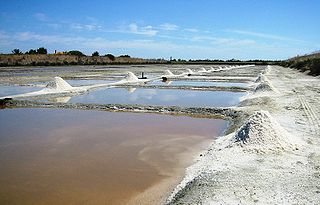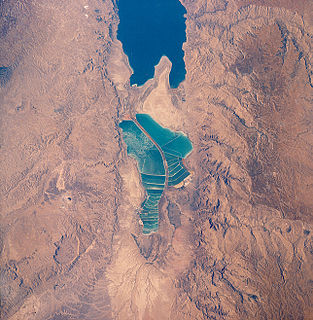Related Research Articles
The halophiles, named after the Greek word for "salt-loving", are extremophiles that thrive in high salt concentrations. While most halophiles are classified into the domain Archaea, there are also bacterial halophiles and some eukaryotic species, such as the alga Dunaliella salina and fungus Wallemia ichthyophaga. Some well-known species give off a red color from carotenoid compounds, notably bacteriorhodopsin. Halophiles can be found in water bodies with salt concentration more than five times greater than that of the ocean, such as the Great Salt Lake in Utah, Owens Lake in California, the Urmia Lake in Iran, the Dead Sea, and in evaporation ponds. They are theorized to be a possible candidate for extremophiles living in the salty subsurface water ocean of Jupiter's Europa and other similar moons.

Natural salt pans or salt flats are flat expanses of ground covered with salt and other minerals, usually shining white under the sun. They are found in deserts and are natural formations.

A salt lake or saline lake is a landlocked body of water that has a concentration of salts and other dissolved minerals significantly higher than most lakes. In some cases, salt lakes have a higher concentration of salt than sea water; such lakes can also be termed hypersaline lakes, and may also be pink lakes on account of their colour. An alkalic salt lake that has a high content of carbonate is sometimes termed a soda lake.

A salt evaporation pond is a shallow artificial salt pan designed to extract salts from sea water or other brines. Natural salt pans are geological formations that are also created by water evaporating and leaving behind salts. Some salt evaporation ponds are only slightly modified from their natural version, such as the ponds on Great Inagua in the Bahamas, or the ponds in Jasiira, a few kilometres south of Mogadishu, where seawater is trapped and left to evaporate in the sun.

Salt, also referred to as table salt or by its chemical formula NaCl, is an ionic compound made of sodium and chloride ions. All life has evolved to depend on its chemical properties to survive. It has been used by humans for thousands of years, from food preservation to seasoning. Salt's ability to preserve food was a founding contributor to the development of civilization. It helped eliminate dependence on seasonal availability of food, and made it possible to transport food over large distances. However, salt was often difficult to obtain, so it was a highly valued trade item, and was considered a form of currency by certain people. Many salt roads, such as the via Salaria in Italy, had been established by the Bronze Age.

Evaporation ponds are artificial ponds with very large surface areas that are designed to efficiently evaporate water by sunlight and expose water to the ambient temperatures.

Mowry Slough is a 5.8-mile-long (9.3 km) slough in Don Edwards San Francisco Bay National Wildlife Refuge and is the primary breeding ground for San Francisco Bay harbor seals. It is situated among the salt marshes and salt evaporation ponds in the city of Fremont.
Idiomarina is a genus of bacteria in the Gammaproteobacteria class, including the sequenced species Idiomarina loihiensis.
Salirhabdus is a genus of bacteria from the family of Bacillaceae.
Salirhabdus euzebyi is a Gram-positive, spore-forming, aerobic, halotolerant and motile bacterium from the genus of Salipaludibacillus which has been isolated from sea salt from the island of Sal in Portugal.
Idiomarina abyssalis is a Gram-negative, halophilic and aerobic bacterium from the genus of Idiomarina which has been isolated from seawater from a depth of 4000 – 5000 metre from the Pacific Ocean.
Idiomarina aestuarii is a Gram-negative, rod-shaped, aerobic and non-motile bacterium from the genus of Idiomarina which has been isolated from seawater from the South Sea in Korea.
Idiomarina atlantica is a Gram-negative, aerobic, slightly curved rod-shaped and non-motile bacterium from the genus of Idiomarina which has been isolated from sediments from Atlantic Ocean.
Idiomarina baltica is a bacterium from the genus of Idiomarina which has been isolated from water from the Baltic Sea.
Idiomarina donghaiensis is a Gram-negative, aerobic, rod-shaped and motile bacterium from the genus of Idiomarina which has been isolated from seawater from the East China Sea.
Idiomarina marina is a Gram-negative, aerobic and heterotrophic bacterium from the genus of Idiomarina which has been isolated from seawater from the An-Ping Harbour in Taiwan.
Idiomarina planktonica is a Gram-negative and non-spore-forming bacterium from the genus of Idiomarina which has been isolated from the Tuosu lake in China.
Idiomarina woesei is a Gram-negative and heterotrophic bacterium from the genus of Idiomarina which has been isolated from seawater from the Andaman Sea in India.
Idiomarina xiamenensis is a bacterium from the genus of Idiomarina which has been isolated from seawater from the Xiamen Island in China.

The San Francisco Bay Salt Ponds are an approximately 16,500-acre (6,700 ha) part of the San Francisco Bay that have been used as salt evaporation ponds since the California Gold Rush era. Most of the ponds were once wetlands in the cities of Redwood City, Newark, Hayward and other parts of the bay.
References
- 1 2 "Idiomarina". LPSN .
- 1 2 "Idiomarina insulisalsae". www.uniprot.org.
- ↑ Taborda, M; Antunes, A; Tiago, I; Veríssimo, A; Nobre, MF; da Costa, MS (September 2009). "Description of Idiomarina insulisalsae sp. nov., isolated from the soil of a sea salt evaporation pond, proposal to transfer the species of the genus Pseudidiomarina to the genus Idiomarina and emended description of the genus Idiomarina". Systematic and Applied Microbiology. 32 (6): 371–8. doi:10.1016/j.syapm.2009.06.005. PMID 19625151.